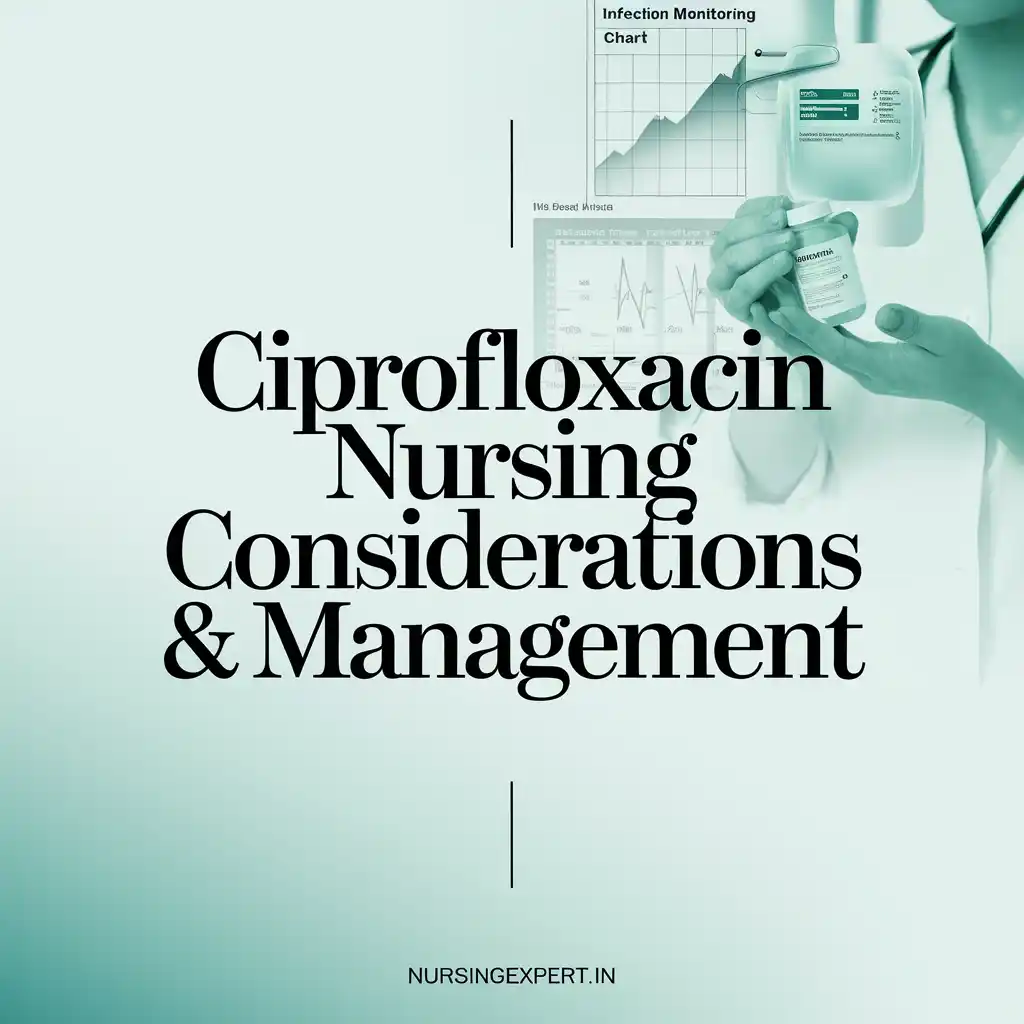Introduction
Ciprofloxacin, introduced in the late 1980s, is a second-generation fluoroquinolone antibiotic celebrated for its broad-spectrum activity against gram-negative pathogens and some gram-positive bacteria. Its ability to penetrate diverse tissues, including the lungs, skin, and prostate, has made it a pivotal agent in managing infections ranging from urinary tract infections (UTIs) to bioterrorism-related anthrax exposure. Since its approval, ciprofloxacin has evolved into a mainstay of antimicrobial therapy, particularly for infections resistant to first-line treatments.
Thank you for reading this post, don't forget to subscribe!
However, its widespread use has revealed a dual nature: while highly effective, ciprofloxacin carries risks of significant adverse effects such as tendon rupture, QT prolongation, and central nervous system (CNS) disturbances. These complexities place nurses at the forefront of ensuring its safe administration and monitoring. Nurses must integrate pharmacological expertise with patient-centered care to optimize outcomes, making this drug a critical topic for nursing education and practice.
Drug Overview
Drug Name
- Generic Name: Ciprofloxacin
- Brand Names: Cipro, Cipro XR, Proquin XR


Classification
Ciprofloxacin belongs to the fluoroquinolone class of antibiotics, known for their synthetic origin and potent bactericidal properties.
Mechanism of Action
Ciprofloxacin targets bacterial DNA replication by inhibiting two key enzymes: DNA gyrase and topoisomerase IV. DNA gyrase facilitates the unwinding of DNA, while topoisomerase IV aids in separating replicated DNA strands. By binding to these enzymes, ciprofloxacin disrupts DNA supercoiling and segregation, halting bacterial cell division and leading to cell death. This concentration-dependent killing is enhanced by a post-antibiotic effect, suppressing bacterial regrowth even after drug levels decline.
Pharmacokinetics
- Absorption: Oral bioavailability ranges from 70-80%, with peak plasma concentrations achieved within 1-2 hours. Food delays absorption but does not significantly reduce it.
- Distribution: Ciprofloxacin exhibits excellent tissue penetration, reaching high concentrations in the lungs, kidneys, and bones. It crosses the blood-brain barrier minimally, limiting CNS accumulation.
- Metabolism: Partially metabolized in the liver into four active metabolites, though the parent compound drives most therapeutic effects.
- Excretion: Approximately 40-50% is excreted unchanged in urine, with a half-life of 3-5 hours in adults with normal renal function. Biliary and fecal excretion account for the remainder.
- Protein Binding: 20-40%, allowing significant free drug availability.
Pharmacodynamics
The efficacy of ciprofloxacin hinges on achieving a peak concentration-to-minimum inhibitory concentration (Cmax/MIC) ratio sufficient to eradicate susceptible pathogens. Its broad-spectrum coverage includes Escherichia coli, Pseudomonas aeruginosa, and Staphylococcus aureus, though resistance patterns necessitate culture confirmation.
Indications
Ciprofloxacin is approved for a wide array of infections caused by susceptible organisms:
- Urinary Tract Infections (UTIs): Effective for both uncomplicated and complicated cases, including pyelonephritis and catheter-associated infections.
- Respiratory Tract Infections: Treats acute exacerbations of chronic bronchitis and hospital-acquired pneumonia, though it is not first-line for community-acquired pneumonia due to streptococcal resistance.
- Skin and Soft Tissue Infections: Addresses cellulitis, abscesses, and diabetic foot infections.
- Bone and Joint Infections: Used in osteomyelitis and septic arthritis, often requiring prolonged therapy.
- Gastrointestinal Infections: Treats traveler’s diarrhea (Shigella, Salmonella), typhoid fever, and complicated intra-abdominal infections with anaerobe coverage.
- Anthrax: Post-exposure prophylaxis and treatment following bioterrorism events, as seen in the 2001 U.S. anthrax attacks.
- Other Indications: Chronic bacterial prostatitis, gonorrhea (resistance increasing), and nosocomial infections from multidrug-resistant organisms.
Limitations: Ineffective against Streptococcus pneumoniae in pneumonia and anaerobes like Clostridium species, requiring alternative agents in such cases.
Dosage & Administration
Adults
- Oral:
- Mild/moderate infections: 250-500 mg every 12 hours.
- Severe/complicated infections: 500-750 mg every 12 hours.
- Duration: 7-14 days for UTIs; 4-6 weeks for osteomyelitis.
- Intravenous (IV):
- 200-400 mg every 8-12 hours, infused over 60 minutes.
Pediatrics
- Oral/IV: 10-20 mg/kg every 12 hours (maximum 750 mg/dose).
- Indications: Limited to complicated UTIs, cystic fibrosis exacerbations, or anthrax exposure due to arthropathy risks.
Renal Impairment
- CrCl 30-50 mL/min: 250-500 mg every 12 hours (oral); 200-400 mg every 12 hours (IV).
- CrCl <30 mL/min: 250-500 mg every 18-24 hours (oral); 200-400 mg every 24 hours (IV).
- Dialysis: Administer post-dialysis to avoid removal.
Administration Guidelines
- Oral: Administer with a full glass of water, ideally on an empty stomach (1 hour before or 2 hours after meals). Avoid co-administration with dairy, antacids, or multivitamins containing divalent/trivalent cations (calcium, magnesium, aluminum, iron), which chelate ciprofloxacin and reduce absorption.
- IV: Dilute in 100-250 mL of compatible fluid (e.g., 0.9% saline or D5W). Infuse over 60 minutes using an infusion pump to minimize vein irritation. Use a dedicated line to avoid compatibility issues.
Nursing Considerations
Assessment
Pre-Administration
- Allergy Screening: Confirm no hypersensitivity to fluoroquinolones or related agents. Cross-sensitivity within the class is common.
- Medical History: Evaluate for:
- Tendon disorders or prior rupture (e.g., Achilles tendon).
- Myasthenia gravis, as ciprofloxacin may worsen muscle weakness.
- Cardiac conditions (e.g., prolonged QT interval, arrhythmias).
- Seizure history or CNS disorders.
- Renal/hepatic dysfunction, diabetes, or electrolyte imbalances.
- Baseline Assessment:
- Vital signs (fever as an infection marker).
- Site-specific symptoms (e.g., urinary frequency, respiratory distress).
- Labs: CBC, creatinine, liver function tests, and culture/sensitivity results.
Risk Factors
- Elderly: Increased susceptibility to tendon rupture, CNS effects, and cardiac complications.
- Steroid Use: Heightens tendonitis risk; assess concurrent medications.
- Electrolyte Abnormalities: Hypokalemia or hypomagnesemia may exacerbate QT prolongation.
Interventions
Administration
- Oral:
- Educate patients to separate doses from interacting substances by 2-4 hours.
- For dysphagia, crush immediate-release tablets (not extended-release) and mix with applesauce.
- IV:
- Ensure proper dilution and slow infusion to prevent phlebitis or hypotension.
- Monitor IV site for redness, swelling, or extravasation.
Monitoring
- Therapeutic Efficacy:
- Expect symptom improvement (e.g., reduced fever, pain) within 48-72 hours.
- Obtain follow-up cultures in complicated infections to verify pathogen eradication.
- Adverse Effects:
- Tendon Issues: Check for pain, swelling, or reduced mobility in weight-bearing joints.
- CNS: Observe for confusion, agitation, or seizures, especially in high-risk patients.
- Cardiac: Monitor ECG in patients with risk factors for QT prolongation.
- GI: Assess for persistent diarrhea suggestive of Clostridium difficile infection.
- Labs: Periodic renal/hepatic function tests; glucose monitoring in diabetics.
Patient Education
- Adherence: “Finish the entire course to prevent resistance, even if symptoms improve.”
- Diet: “Avoid dairy, antacids, or iron supplements near dosing times—they block absorption.”
- Side Effects: “Report tendon pain, dizziness, or rash immediately.”
- Photosensitivity: “Wear sunscreen and protective clothing outdoors.”
- Emergency Signs: “Call for help if you experience swelling, breathing difficulty, or chest pain.”
Adverse Effects
Common
- Gastrointestinal: Nausea, vomiting, diarrhea, abdominal discomfort.
- Neurological: Headache, dizziness, insomnia, vivid dreams.
- Dermatological: Rash, pruritus.
Serious
- Tendonitis/Rupture: Predominantly affects the Achilles tendon; risk factors include age >60, steroids, and renal failure.
- QT Prolongation: May precipitate torsades de pointes; contraindicated with other QT-prolonging drugs.
- CNS Toxicity: Includes seizures, psychosis, or tremors; more frequent in the elderly or those with CNS history.
- Hypersensitivity: Anaphylaxis or severe skin reactions (e.g., Stevens-Johnson syndrome).
- Hepatotoxicity: Rare but includes hepatitis or liver failure.
- Hematologic: Leukopenia, anemia, or thrombocytopenia (infrequent).
Black Box Warnings:
- Tendon rupture risk.
- Worsening of myasthenia gravis.
- Serious CNS and psychiatric effects.
Drug Interactions
- Cation-Containing Products: Antacids, sucralfate, iron, calcium reduce absorption; separate by 2-4 hours.
- Theophylline: Elevates levels, risking toxicity (e.g., seizures); monitor closely.
- Warfarin: Potentiates anticoagulation; check INR frequently.
- QT-Prolonging Drugs: (e.g., amiodarone, sotalol) increases arrhythmia risk.
- NSAIDs: May enhance CNS stimulation.
- Steroids: Amplify tendon rupture risk.
- Antidiabetics: Alters glucose levels; adjust doses as needed.
Special Populations
Pregnancy
- Category C: Animal studies suggest cartilage damage; use only if alternatives are unsuitable.
Lactation
- Excreted in breast milk; weigh risks to infant (e.g., diarrhea, thrush) versus maternal benefit.
Pediatrics
- Limited use due to arthropathy concerns; monitor joint development in prolonged therapy.
Elderly
- Adjust doses for renal decline; heightened risk of adverse effects requires close monitoring.
Renal Impairment
- Reduce doses to prevent toxicity; monitor for neurotoxicity or crystalluria.
Immunocompromised
- May need extended courses or adjunctive therapy; watch for superinfections.
Patient Case Examples
Case 1: Adult with Complicated UTI
Profile: A 38-year-old female with recurrent UTIs presents with fever (38.5°C), flank pain, and urgency. Culture reveals multidrug-resistant E. coli. Ciprofloxacin 500 mg orally every 12 hours for 14 days is ordered.
Nursing Actions:
- Assess for tendon pain, given her active lifestyle (runner).
- Teach avoidance of dairy/antacids near doses.
- Monitor hydration and renal function.
- Educate on reporting CNS symptoms (e.g., anxiety, dizziness).
Case 2: Elderly Patient with Pneumonia
Profile: A 78-year-old male with COPD and penicillin allergy is admitted with pneumonia (fever, cough, dyspnea). Ciprofloxacin 400 mg IV every 12 hours is prescribed.
Nursing Actions:
- Obtain baseline ECG to rule out QT prolongation.
- Infuse IV over 60 minutes, checking for phlebitis.
- Implement fall precautions due to dizziness risk.
- Educate on tendon pain reporting, given mobility aid use.
Antibiotic Resistance and Stewardship
Rising resistance to ciprofloxacin, especially among E. coli and Pseudomonas, threatens its efficacy. Nurses support stewardship by:
- Advocating for pre-treatment cultures.
- Reinforcing adherence to prevent resistant strains.
- Reporting treatment failures promptly.
- Educating against misuse for non-bacterial illnesses.
Conclusion
Ciprofloxacin’s role in treating complex infections is undeniable, yet its risks demand rigorous nursing oversight. Through detailed assessments, precise administration, vigilant monitoring, and patient education, nurses safeguard its efficacy while mitigating harm. This guide empowers nursing professionals to navigate ciprofloxacin’s challenges, enhancing patient care and combating resistance.
FAQs
- Can I take ciprofloxacin with milk or yogurt?
No, dairy products interfere with absorption. Take it with water and avoid dairy within 2 hours of dosing. - How quickly does ciprofloxacin work?
Symptoms often improve within 48-72 hours, but complete the full course to ensure eradication. - What if I miss a dose?
Take it as soon as possible unless it’s near the next dose; then skip and resume. Avoid doubling up. - Is ciprofloxacin safe in pregnancy?
It’s Category C—used only if benefits outweigh risks. Safer options like penicillins are preferred. - Can I exercise while on ciprofloxacin?
Light activity is okay, but avoid intense exercise due to tendon risks. Report pain immediately. - Does ciprofloxacin increase sun sensitivity?
Yes, it can cause photosensitivity. Use sunscreen and cover up outdoors. - What are signs of tendon rupture?
Sudden pain, swelling, or bruising in tendons (e.g., Achilles). Seek urgent care. - Can I drink alcohol with ciprofloxacin?
Avoid alcohol—it may worsen dizziness or stomach upset. - How does ciprofloxacin affect blood sugar?
It can raise or lower glucose. Diabetics should monitor levels closely. - Is ciprofloxacin effective against all infections?
No, it’s ineffective against some bacteria (e.g., streptococci, anaerobes). Cultures guide therapy.


